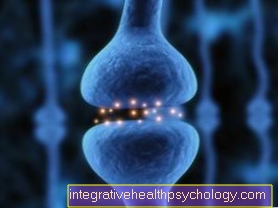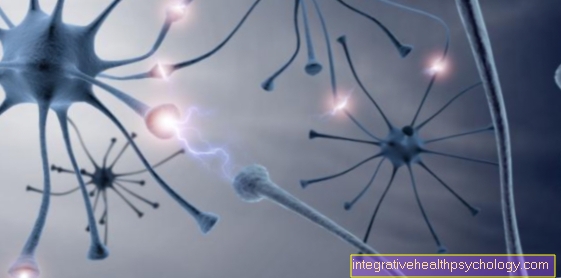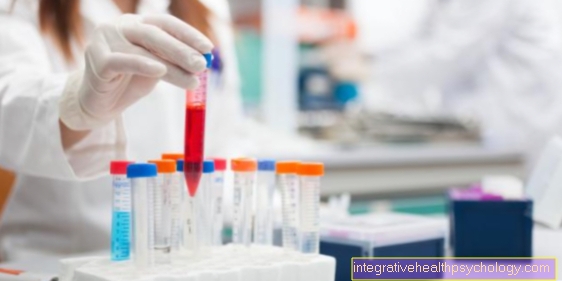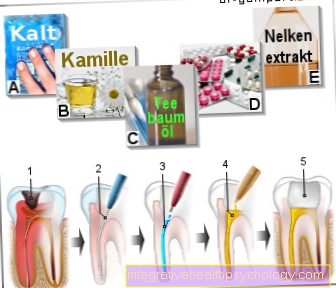Reye syndrome
introduction
Reye's syndrome is a rare condition that primarily affects children between the ages of four and nine. This results in damage to the brain, a so-called encephalopathy, as well as inflammation of the liver, which is characterized by its fatty tissue. This can eventually lead to liver failure.
Reye's syndrome usually manifests itself after a viral infection, for example after an infection with the flu virus or the chickenpox virus. The use of certain medications can also lead to the development of Reye's syndrome.

causes
Taking Aspirin® is considered to be the cause of the development of Reye's syndrome in children. Genetic causes are also discussed, as some people seem more prone to Reye's syndrome. If children suffer from viral infections (e.g. influenza infection, chickenpox infection) and receive Aspirin® therapeutically, the risk of developing Reye's syndrome is increased. Therefore, children should only receive Aspirin® in exceptional cases. However, the disease has also been observed in children who had not previously taken Aspirin®.
In addition to the association with infections with the typical flu viruses, a connection with viruses that cause gastrointestinal diseases (enteroviruses) was also found. At the cellular level, Reye's syndrome malfunctions in the mitochondria. Mitochondria are the "power plants" of the body's cells and are essential for the metabolism, as they control important energy utilization cycles using oxygen. In Reye's syndrome, various enzymes in the mitochondria are disturbed, so that, for example, the toxic ammonia accumulates in the body. In addition, the acidic metabolic product lactate and long-chain fatty acids are stored in the tissues and organs. In the liver, the fatty acids lead to fatty tissue. This also impairs liver function. The ammonia leads to the development of encephalopathy in the brain, severe damage to the brain that can cause permanent damage.
Overall, it can be said that the connections between Reye's syndrome and viral infectious diseases, as well as the intake of acetylsalicylic acid (Aspirin®), have not yet been clearly clarified. The genetic risk for the disease has not yet been proven beyond doubt. It is only certain that the disease usually manifests itself in children following a viral infection and that there is often an association with Aspirin®. The exact connections are unclear.
Aspirin® as the cause of Reye's syndrome
Aspirin®, or the active ingredient acetylsalicylic acid, is not permitted for children under 15 years of age and is strictly contraindicated.
Taking Aspirin® in children can lead to so-called Reye's syndrome. The cause of Reye's syndrome is not fully understood. What is certain is that in addition to taking Aspirin®, which leads to Reye's syndrome, there is often a viral infection, which is sometimes not noticed.
Taking Aspirin® together with the virus infection leads to severe liver dysfunction. The liver can no longer break down the breakdown products created in the body such as some ammonia. Ammonia is harmful to the central nervous system. This leads to a so-called encephalopathy, a change in the brain that, in the case of Reye's syndrome, is associated with a loss of consciousness and, in the further course, with a personality change.
The first symptom of Reye's syndrome is often symptoms such as nausea and severe vomiting.
Symptoms
Reye's syndrome can theoretically occur at any age, but it usually develops by the age of ten.
At the beginning of the disease, this manifests itself as sleepiness, lethargy, vomiting, constant crying, fever, irritability and impaired liver function. There are also gastrointestinal symptoms such as nausea and severe vomiting. About 30% of patients develop encephalopathy during the course of the disease, which can be accompanied by severe symptoms. These include, for example, an accumulation of fluid in the brain (cerebral edema) that leads to swelling of the brain, breathing too fast (hyperventilation) or respiratory arrest, seizures, increased reflexes (hyperreflexia) or failure of the reflexes (areflexia), a spastic extension of the extremities (decerebral rigidity) or a progressive disturbance of consciousness up to a coma.
diagnosis

In some cases, the diagnosis of Reye's syndrome can already be suspected by asking the child or parents. If the child suffered from a viral infection shortly before the symptoms developed and was treated with Aspirin®, this can already be an indication. To confirm the diagnosis, the blood is usually examined first. In Reye's syndrome, increased liver values, increased values of amino acids, fatty acids and ammonia, as well as other increased enzyme levels are noticeable. The blood sugar is often too low (hypoglycaemia). Since the liver is also involved in blood clotting, the impairment of the synthesis capacity (production capacity) of the liver can lead to delayed blood clotting.
When the sick child's abdomen is palpated, an enlargement of the liver can often be observed. A sample of liver tissue can also be taken that would show fatty tissue in Reye's syndrome.
Additional imaging is often requested to rule out other diseases. Computed tomography (CT) of the skull is performed to rule out space-occupying processes in the brain, especially if the child is no longer clearly conscious. If there is cerebral edema (fluid accumulation in the brain tissue), this can also be visible on the CT.
therapy
The cause of Reye's syndrome cannot be treated directly. Therefore, the therapy relies on the treatment of the Symptoms the disease. The affected children mostly have to monitored by intensive care become. Often there is one Ventilation and Sedation of the children necessary.
Of the Intracranial pressure must also be monitored. In order to reduce the cerebral edema and thus the intracranial pressure, for example Mannitol are given. This is a substance that is used to multiply drainage and can reduce the fluid in the brain tissue.
The increased ammonia levels in the blood can for example by a B.also skin dialysis (Peritoneal dialysis).
forecast
In a severe form of Reye's syndrome, it happens roughly ¾ of the cases to death of the sick children. Hence a early start of therapy of paramount importance in the early stages of the disease. This can significantly reduce the high mortality rate.
Current Studies suggest that Reye's syndrome is just one 25% mortality out. About 1/3 of the children developed permanent damage, for example neurological deficits or Impairments of Spoke- and Learning ability.
prophylaxis

There is no direct prophylaxis to prevent the development of Reye's syndrome. The only option is to refrain from using Aspirin® in children and adolescents with viral infections, as this is seen as the greatest risk factor for the disease.
What drugs are suitable for treating pain and fever in children?
Due to the existing assumption of a connection between Reye's syndrome and the intake of Aspirin®, the administration of Aspirin® should definitely be avoided.
Paracetamol and ibuprofen are the drugs of choice for pain and fever. The choice of medication and the dosage depends on the age and weight of the child.
Ibuprofen
Ibuprofen belongs to the group of non-steroidal anti-inflammatory drugs (NSAIDs). Ibuprofen has an antipyretic, analgesic and anti-inflammatory effect.
The drug is approved from an age of over 3 months or from a weight of over 6 kg.
The dosage in children should be adapted to the body weight of the child. In the event of uncertainty regarding the dosage or use, consultation with the pediatrician should be sought. In addition to the tablet form, ibuprofen for children is also available as a juice, as a powder to dissolve or as a suppository.
Ibuprofen should not be given if you have a known allergy or if you have severe kidney or liver impairment.
Paracetamol
Paracetamol is this First choice drug in children to treat fever and pain. It belongs to the group of non-steroidal anti-inflammatory drugs (NSAIDs).
The preparation is approved from a weight of 3 kg.
Paracetamol must not be used in premature babies and newborns because the liver is still immature.
Paracetamol has an antipyretic and analgesic effect. Unlike ibuprofen, it has no anti-inflammatory component.
In the case of paracetamol, the dosage must also be adjusted to the body weight of the child. Paracetamol overdoses must be avoided at all costs become. The child's liver in particular quickly reaches its capacity to break down the active ingredient. The consequences of overload are severe Liver damage with death of the liver cells. Therefore, the pediatrician should be consulted before the first dose. A toxic dose is reached at 150 grams per kilogram of body weight.
history
Reye's syndrome was first described in Australia in 1963. The first person to describe it was the pathologist Ralph Douglas Kenneth Reye (* April 5th, 1912 in Townsville, † July 16th, 1977). However, a few years passed before the connection between the disease and the possible triggers (viral infections, Aspirin®) could be established.

















.jpg)











